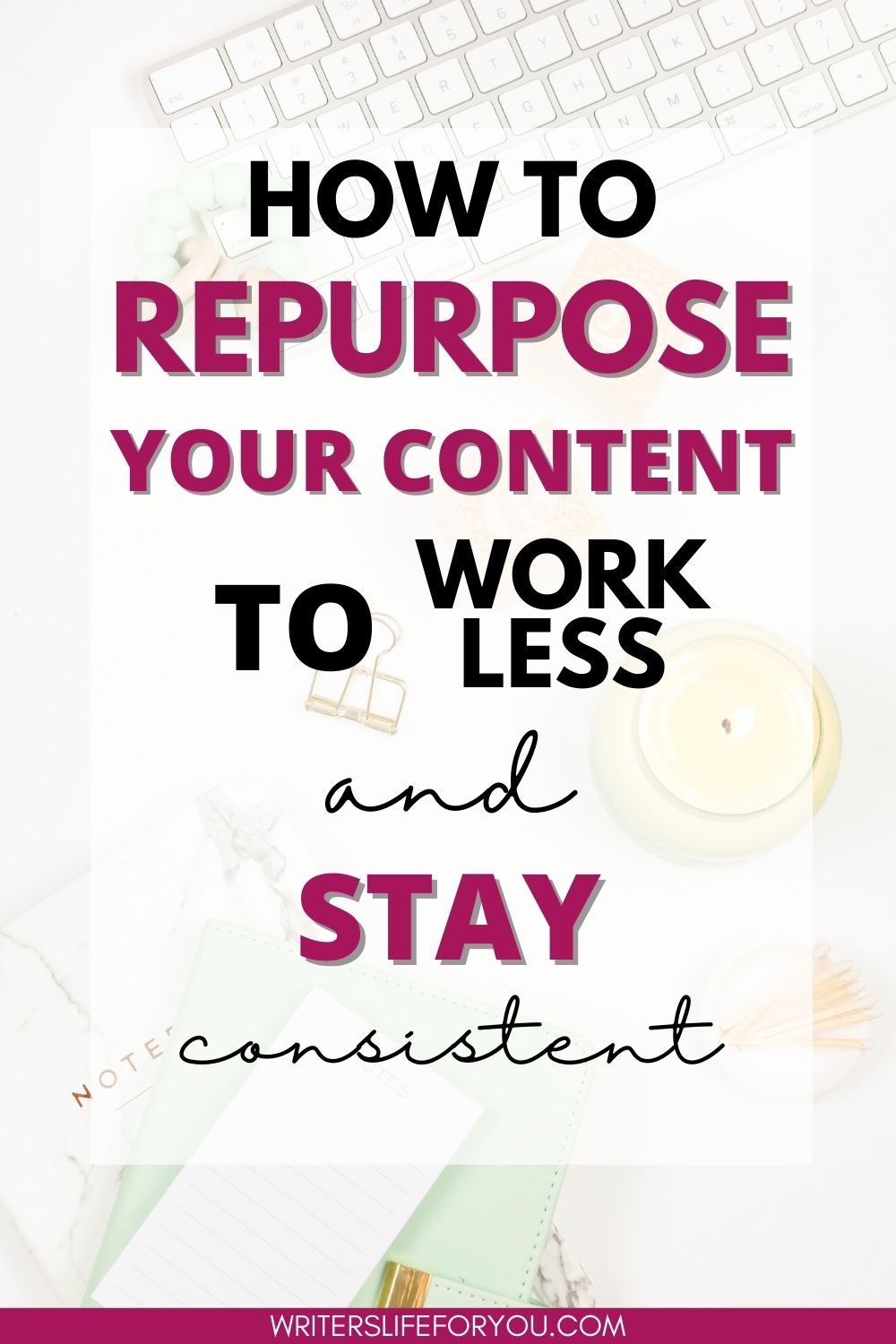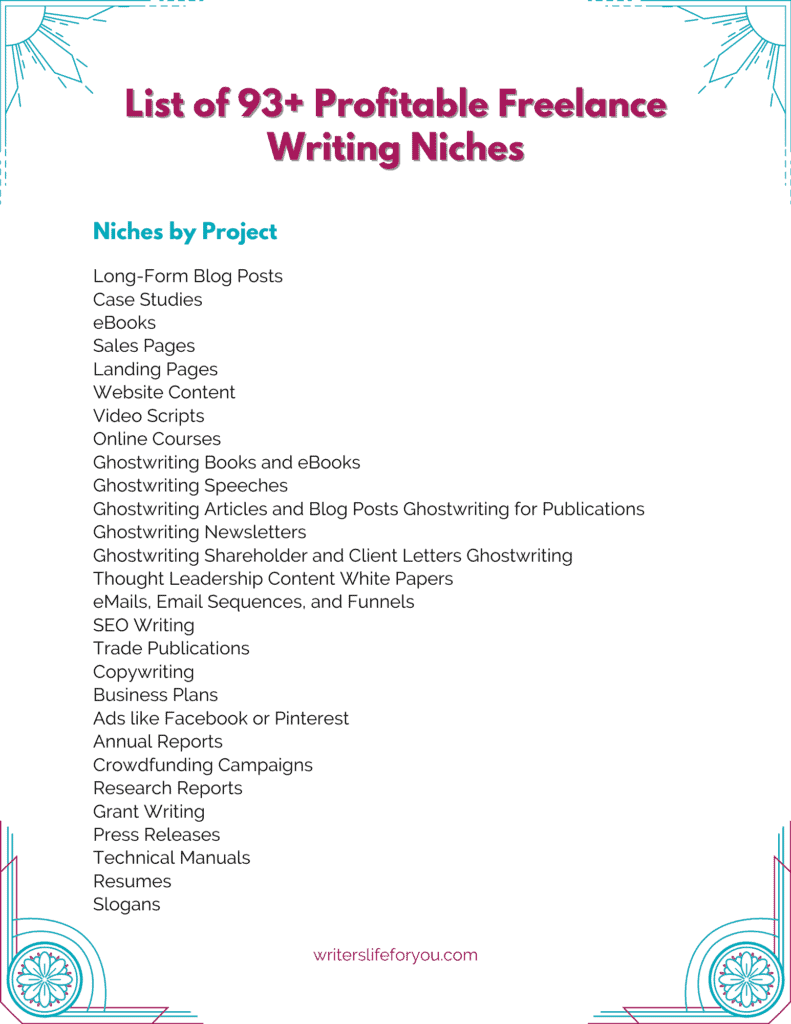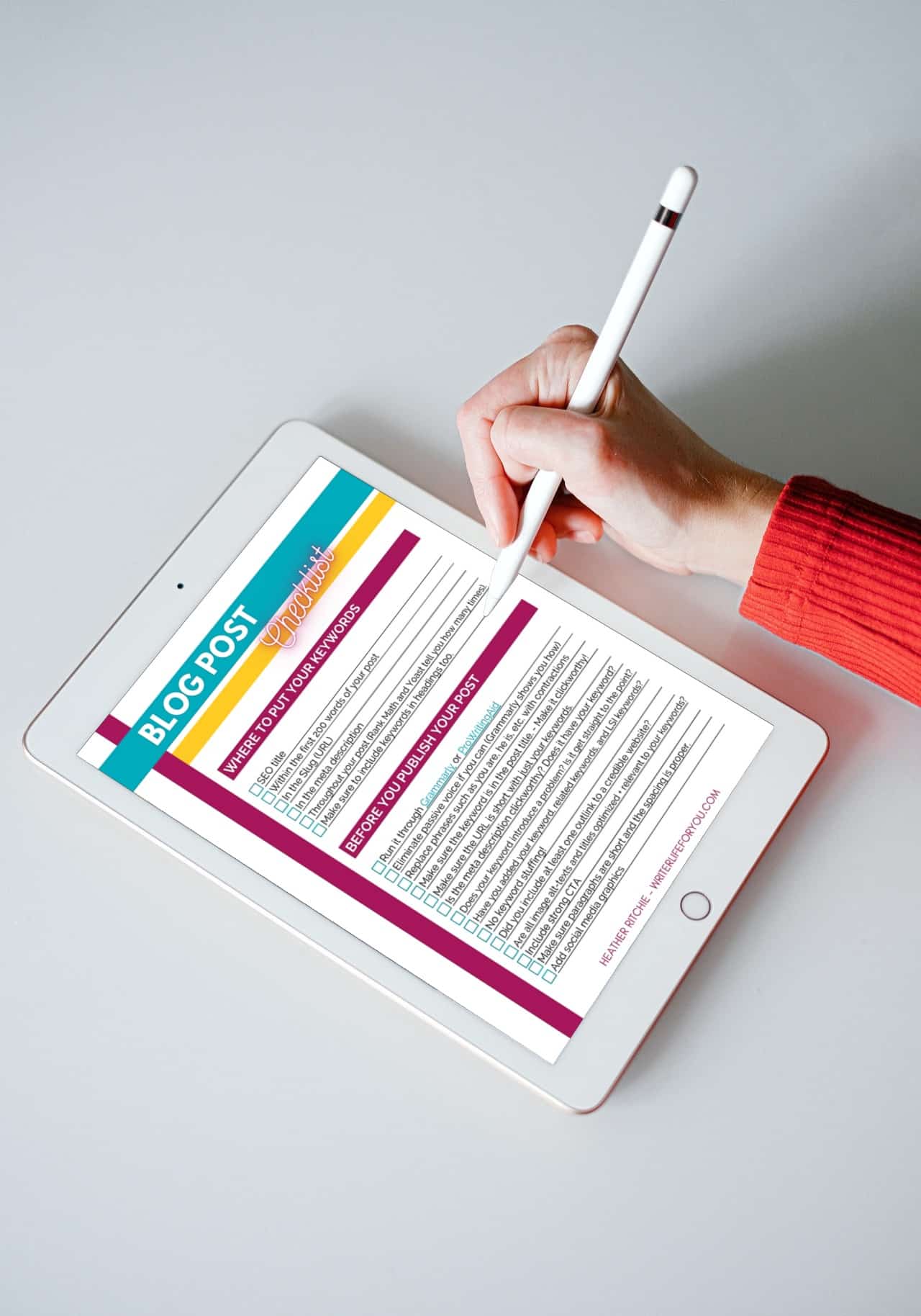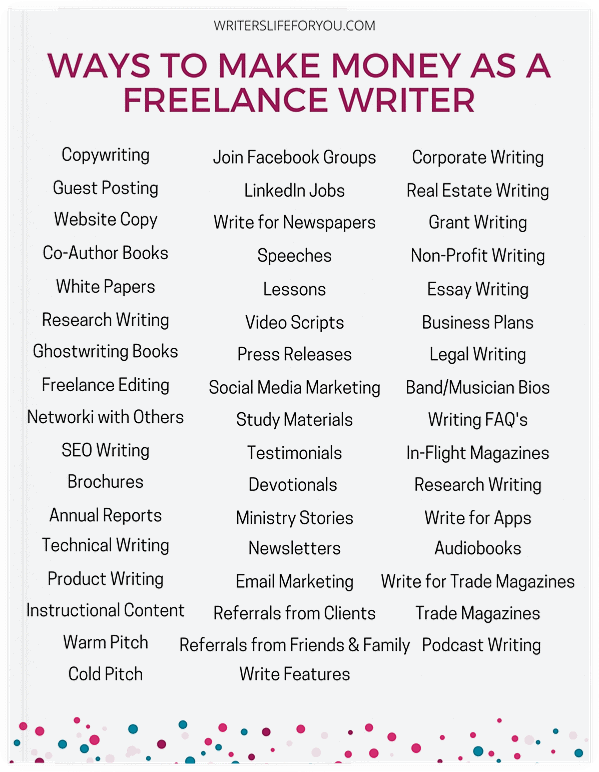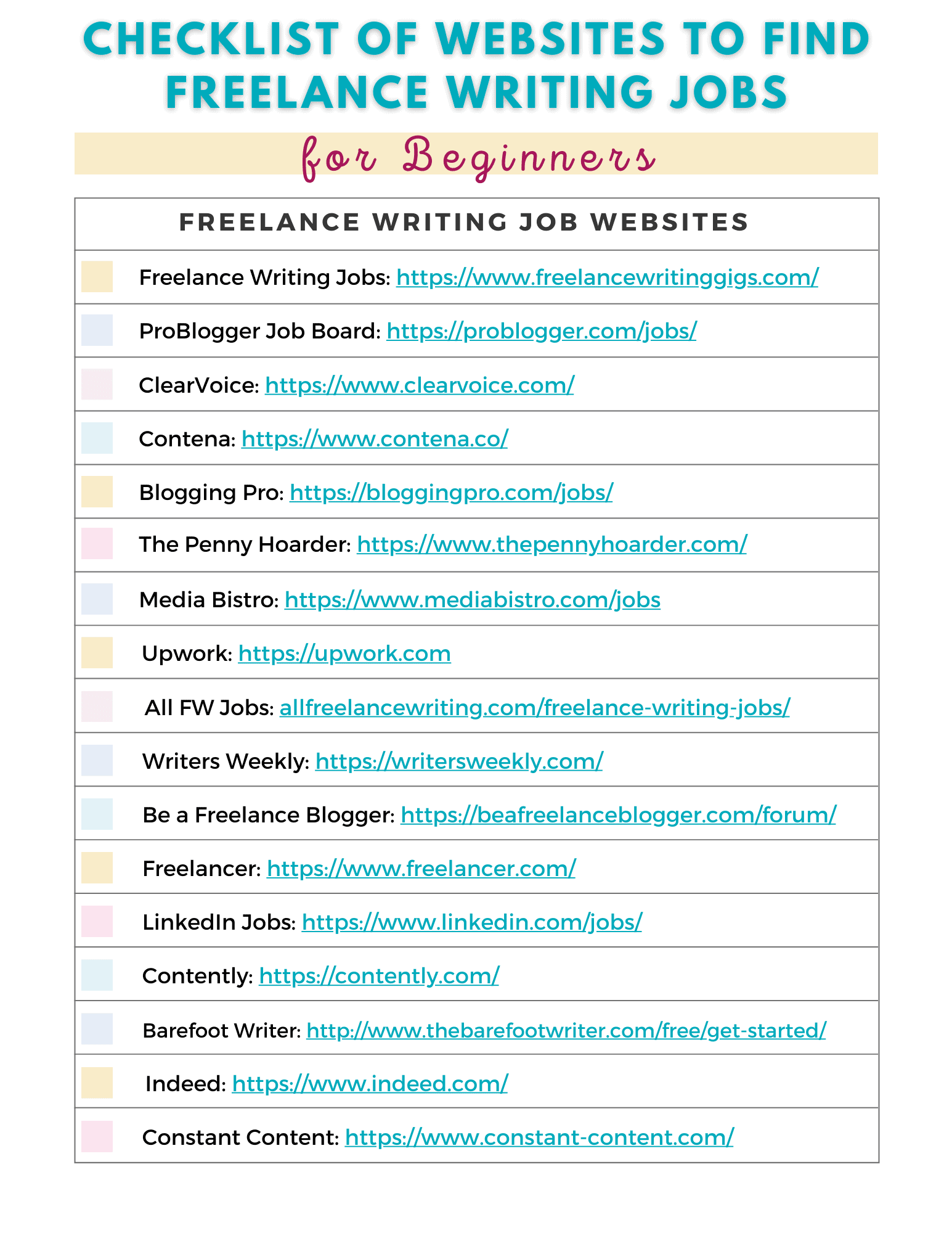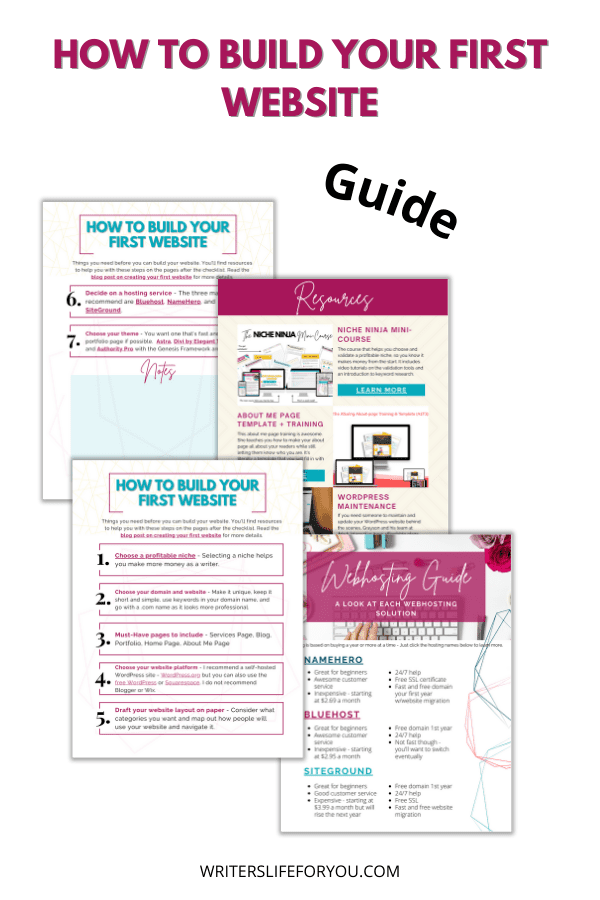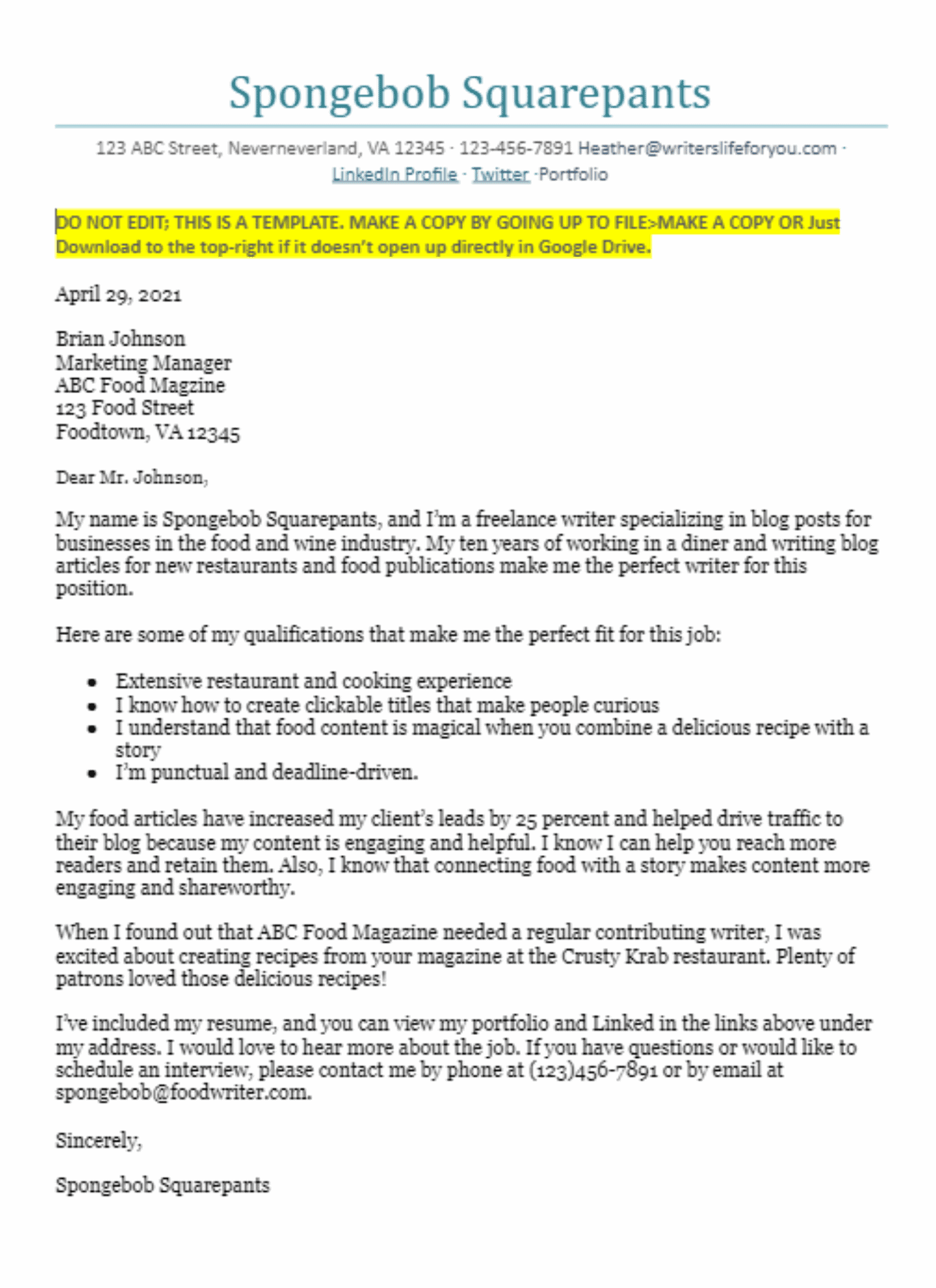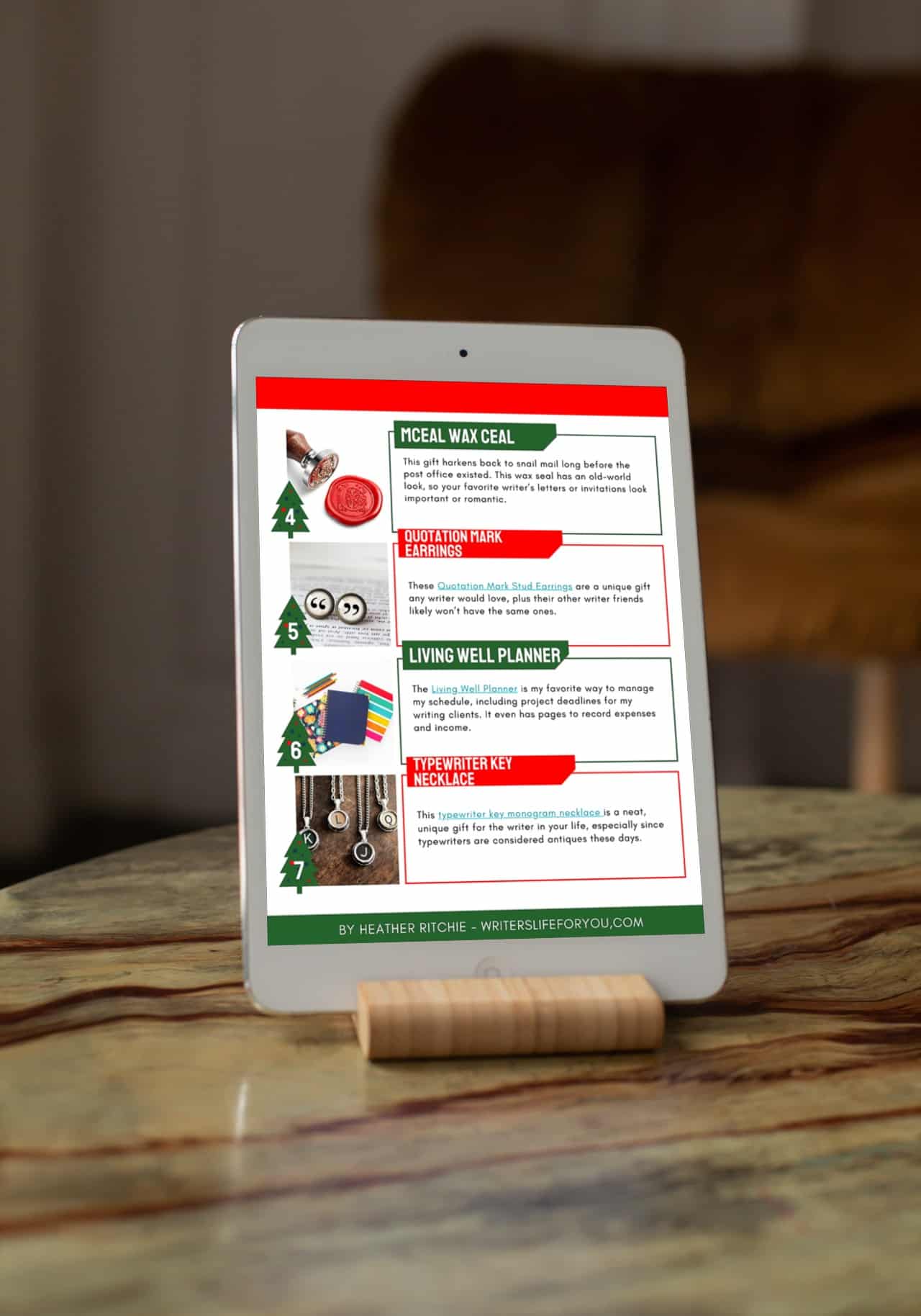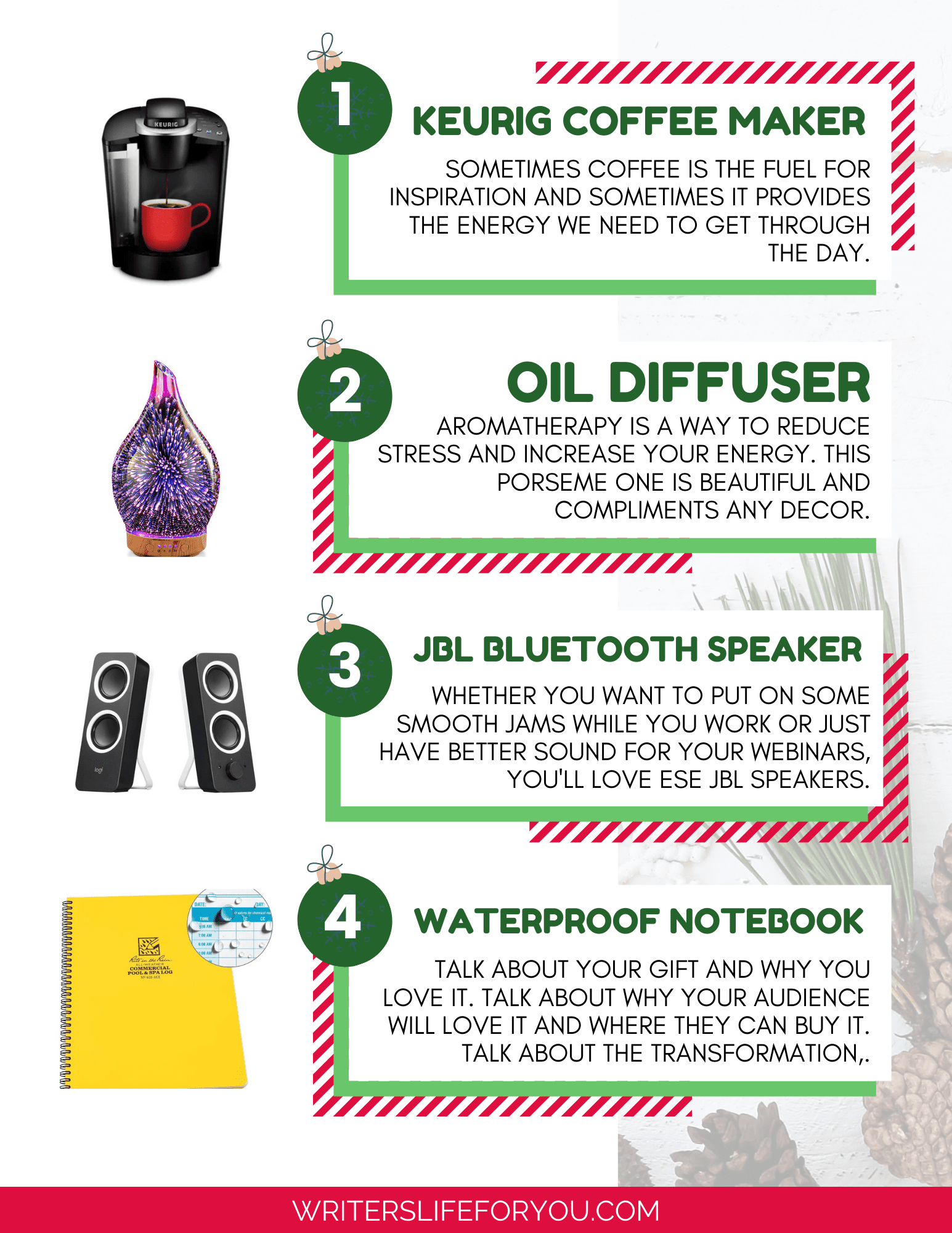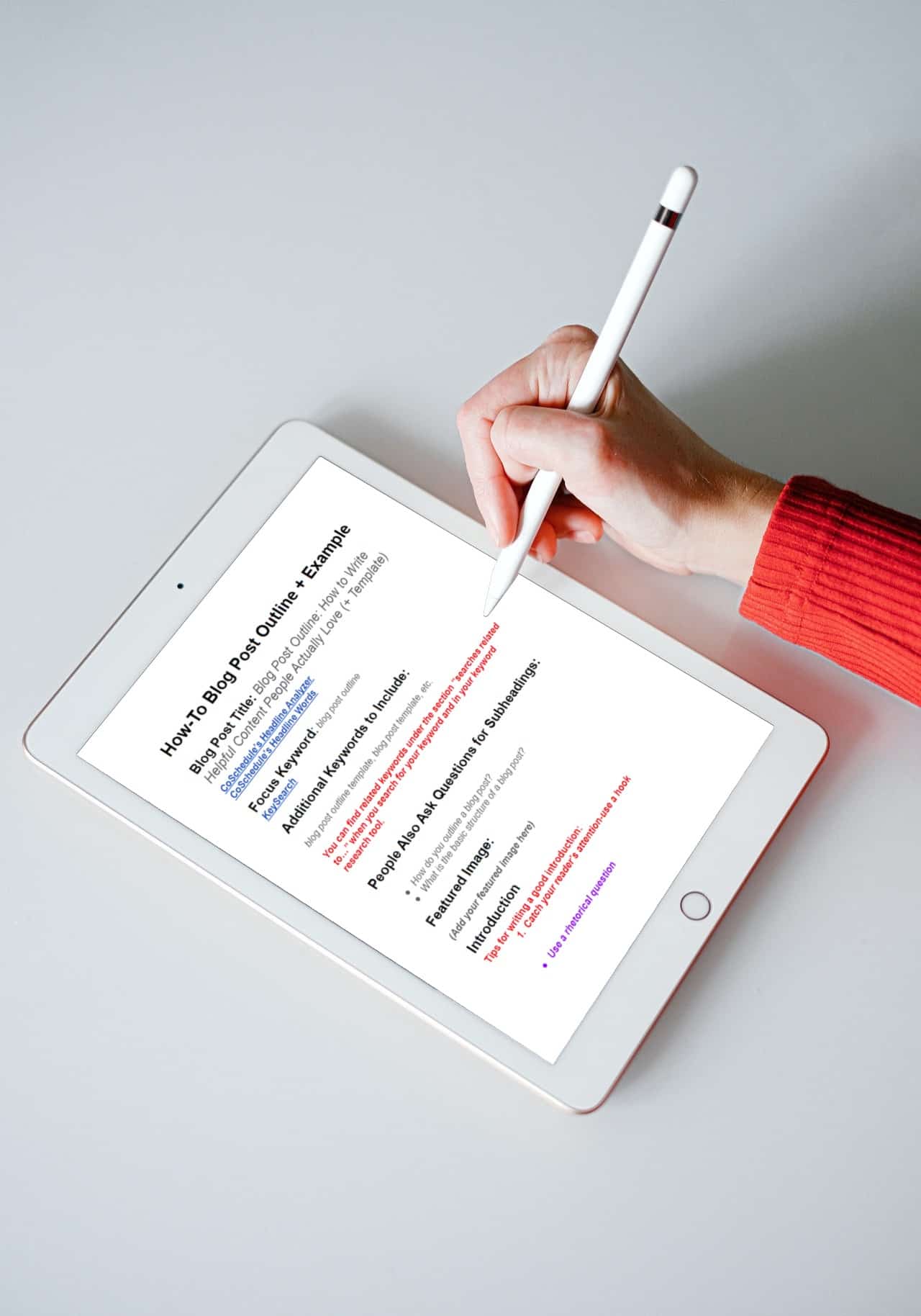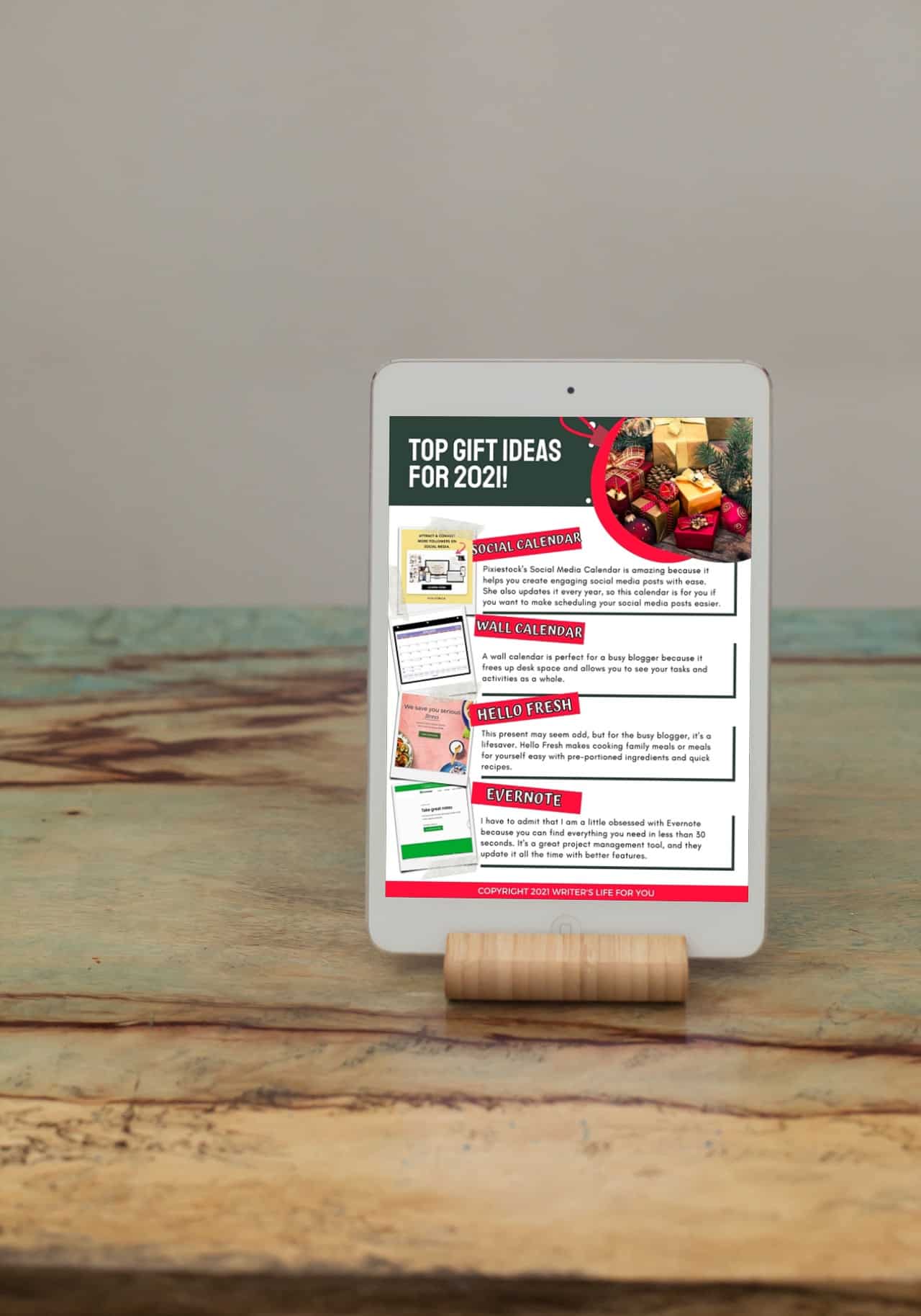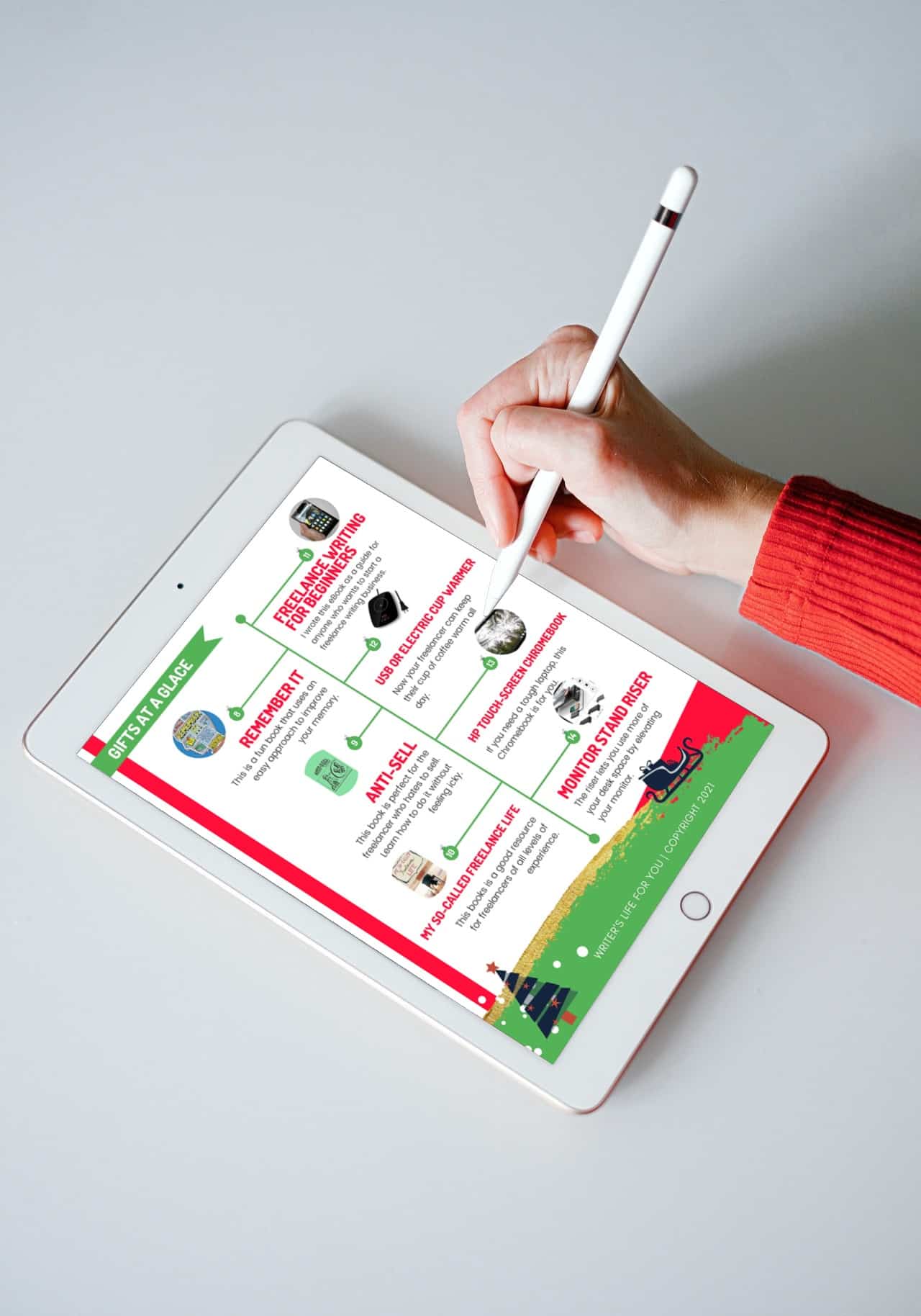Content repurposing workflow to use in your content plan.
Is the content creation process taking up way too much time in your business? Or maybe you want to know how to get off the content creation hamster wheel.
I get it! Content creators spend way too much time writing blog posts, posting on social media, creating videos and podcasts, and whatever else you need in your biz.
And I used to spend a crazy amount of time doing all that until I discovered the magic of content repurposing.
You see, I’m a Gen Xer, the generation taught by baby boomers that the way to make more money is to work harder. The harder you work, the more money you make.
In fact, I thought that if something was “too easy,” I was doing it wrong. However, I realized that working smarter, not harder, is the best philosophy when you’re essentially a solopreneur running everything on your own (with a smidge of help in some areas).
So, I wanted to help YOU work smarter, not harder, with a content repurposing workflow that will help you get more mileage out of every piece of content you create.
After reading this post, you’ll:
Know exactly what content repurposing is
Have a content repurposing workflow you can tweak and make your own
Learn the benefits of content repurposing
Understand the importance of having a content marketing strategy and plan
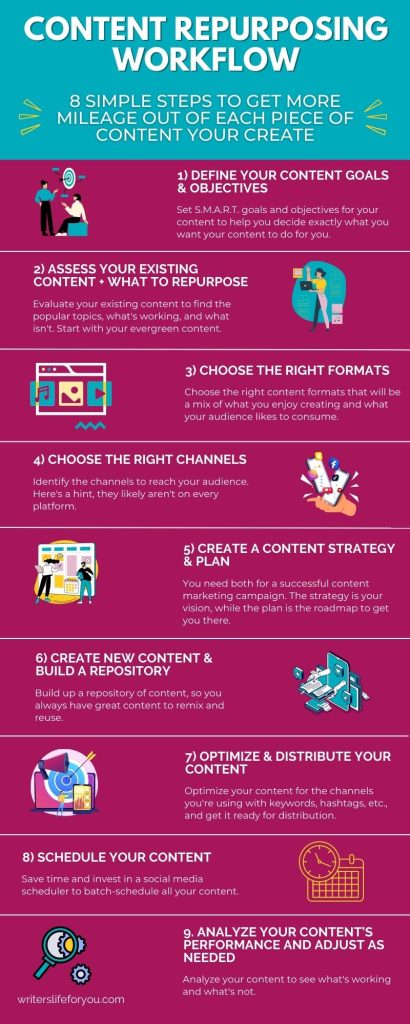
Why It’s Important to Have a Content Strategy and Plan
Before I get into what content repurposing is, I want to make sure you have some type of content strategy and plan in place. You need both for a successful content marketing campaign; after all, we don’t want to be creating content just for the sake of creating content.
You need to have a purpose for every piece of content you create. I saw this brilliant illustration of the importance of a content strategy and plan somewhere:
Your content strategy is your vision, and your content plan is the roadmap to get you there. Content planning builds a bridge from your strategy to the execution of a content marketing campaign.
Having a strategy and plan for your content helps you understand the content you need to create to meet your business goals and grow your brand. After years of writing content for myself and others, I developed the PACCMAN Content Planning Framework – the framework I teach in my Content Planning 101 course.
And repurposing content is a key part of my strategy to do more in less time.
What is Content Repurposing
Let’s face it; creating fresh content is one of the most critical parts of your marketing strategy – content marketing. Basically, anyone that uses content to attract their ideal audience is doing content marketing whether they know it or not.
So, why not extend the life of all the content you create? That my friend is content repurposing. Content repurposing entails revising or adding to the content you’ve already made to increase its value.
Recycling and remixing content comes in many forms, such as:
- Taking a long-form blog post and pulling pieces out for social media, your email newsletter, or adapting it to a current trend
- Taking a blog post and turning it into a video or podcast episodes
- Creating an infographic (like the one in this article) for a blog post
- Creating short videos like Instagram reels or TikTok videos from a YouTube video or another piece of content
You can really take any piece of long-form content or video content and repurpose it for an endless array of other forms. For example, many of the key elements of this blog post actually come from my Content Planning course. I didn’t need to start from scratch.
A solid content repurposing strategy saves you time because you don’t need to reinvent the wheel whenever you need to schedule social media posts or write a blog article.

Benefits of Repurposing Your Content
Having a content repurposing strategy makes it easier to scale your content, meaning you don’t have to begin from scratch each time you create a piece of content.
Repurposing content has many benefits that help your overall content strategy.
Increased Brand Awareness and Your Online Presence
Creating more quality content increases your online presence and brand awareness. A strong online presence is important for building your audience, getting more clients and customers, and introducing your brand to more people.
It Builds Your Authority
Building your authority is part of getting people to buy your products and services. People need to see you as a leader in your industry to entrust you with solving their problems.
When you repurpose content, it allows you to show up in new places in front of a new audience (as well as old ones) and showcase yourself as an expert in your niche.

Greater Engagement and Audience Loyalty
Since repurposing your content gets you in front of more people, it should reach your target audience if you are niched down right. (The more niched down you are, the easier it is to create content for your ideal audience.)
When you expand your reach and build your authority, you’re also increasing brand loyalty and in turn, increasing engagement with your content. Once you connect with people on your various channels, they will start following you, which is when you can create true fans.
It Helps Maintain Consistency
Consistently producing content is something many content creators struggle with, and it’s no wonder with all the hats we wear. A content repurposing strategy ensures you’re always regularly churning out fresh new content.
This was probably one of the most significant benefits I got from repurposing content.
It Diversifies Your Content
Consistency isn’t the only key factor in the success of your content marketing; producing fresh content is too. You can take old blog posts and add to or edit them for a new take on the topic.
Repurposing your content into various formats will help you maintain consistent messaging across multiple channels and platforms while easily creating new content.
You Can Experiment With Different Formats and Styles
Testing and analyzing are part of any good content marketing strategy. You always want to see what’s working and what isn’t, which often means trying different content formats and styles.
You may be shocked at what will attract your ideal audience, and you won’t know unless you try new things. Plus, that prevents your content from becoming stale and dull and will attract more people.

Better SEO and Search Engine Rankings
Google likes to rank your content based on your authority on a topic, so having multiple pieces of content in different formats linking back to a pillar post improves your rankings. It also allows you to control the anchor text you use to link the repurposed content back to your original posting allowing for a variety of keyword variations.
This process creates some solid backlinks for SEO and consistently drives more traffic to your website.
It Saves Time (AND, As a result, money)
Spending less time creating content allows you to focus on the other money-making aspects of your biz, like creating courses and digital products or launching new services. That means you can spend more time promoting your content which is a crucial part of content marketing that many people let slide – myself included.
You Can Cover the Whole Buyer’s Journey
Each stage of the buyer’s journey requires you to answer different search intents and focus on other aspects of a topic. Repurposing content allows you to target different stages of the buyer’s journey.
For instance, a lot of evergreen content like blog posts or even social media posts is great for the awareness stage when the buyer becomes aware that they have a problem.
During the consideration phase, when a buyer is considering options to solve their issue, email campaigns or sales pages can provide more helpful information.
Once buyers enter the decision stage, they begin evaluating the options available to them and decide on who to purchase from. Testimonial posts on social media and case studies on how your product has helped real people are great pieces of content to publish.
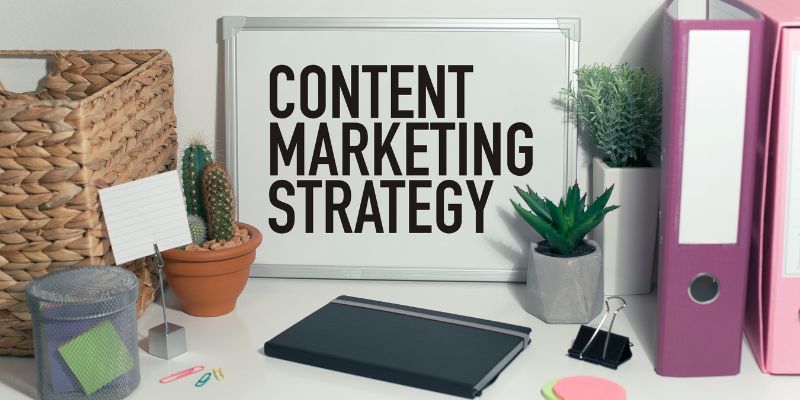
How to Create 30+ Pieces of Content with This 8-Step Ultimate Content Repurposing Workflow
Adding a content repurposing process to your content creation workflow creates a system that allows you to continue to grow and make more money with your content. Here are the main steps to my content repurposing workflow.
Step 1 – Define Your Content Goals and Objectives
The first thing you want to do when creating a content repurposing workflow is to set clear content objectives and goals.
Believe it or not, there is a difference between goals and objectives. Your content goals are the outcomes you want to achieve with your content, while your objectives are the specific, measurable actions you need to take to reach your goals.
With each objective you complete, you’re getting closer to achieving your goal. Setting objectives can help you see the exact steps you need to take to reach each goal.
So, if your goal is to get more email subscribers and nurture them, some objectives could be:
- Create a new lead magnet
- Setup your opt-in form
- Choosing the long-form piece of content you want to repurpose for this goal.
- Decide on the number of pieces of new content you want to create
Goals are typically broad statements when written out and not a step-by-step process, and they are often considered long-term desires, while objectives are the individual things you need to do to achieve a goal. But keep in mind that one goal can have multiple objectives.
You’ll want to create overall goals for repurposing your content, but you also want each piece of content to have a purpose.

Defining Your Goals and Objectives
To set your goals and objectives, you want to start with defining your audience, as this is the key to success for content marketing.
Then you want to think about your content goals or what you want your content to do. Common goals include:
- Increasing your website traffic
- Growing your brand’s audience
- Increasing brand awareness
- Generating more sales and leads
- Improving your brand’s reputation with search engines
- Increasing loyalty and deepening relationships with clients and customers
- Increasing community engagement
- Directly increasing your revenue
- Nurturing your audience
- Increasing brand authority
Once your main goals are set, decide on objectives you can use as milestones to help you reach each specific goal. Your objectives will differ for each of the goals above, so keep that in mind.
Step 2 – Assess Your Existing Content + How to Choose What to Repurpose
Then the next part of the repurposing workflow involves assessing your existing content. Identify your most popular content using tools like Google Analytics, Google Search Console, and social media analytics.
I’ll give you bonus points if you take this a step further and see how you can replicate your most successful posts by coming up with new content ideas along the same lines.
For instance, one of my most popular posts on social media is on ghostwriting, so I could brainstorm other ideas I could write using the same structure or similar topics to ghostwriting.
What similar posts could I write on ghostwriting, or is there a structure I could replicate on a similar topic like freelance writing?
Then evaluate each piece of content’s relevance and value and consider how you could make it even more valuable. When looking at relevance, consider how relevant that topic is right now.
Is it a seasonal topic or trend on its way out? If so, it’s not the best content to repurpose unless you can pull relevant ideas out.
Evergreen content is the best to repurpose because it’s timeless and will never go out of style.
For instance, my posts on how to be a ghostwriter or freelance writer will always be relevant. I may find new ideas to update it, but it’s not a seasonal or trending topic (though it may be more popular at certain times of the year).
Evergreen blog posts and long-form video and audio content are usually great pieces to repurpose. I like to turn blog posts and pillar content into social media posts and email newsletters.
Now does this mean you can never repurpose seasonal content or similar topics? The answer is no; you can reuse that seasonal content at the same time each year.
For instance, I have a post on ways to make extra money for Christmas that is popular during the last half of the year going into the holidays. Or I have a post on maintaining focus on work when the kids are home for the holidays.
Just make sure that you aren’t recycling topics at the wrong times of the year.

Step 3 – Choose the Right Formats
Then you want to choose the right content formats, which are based on what ideal audience likes to consume content and the type of content you enjoy creating.
The exception to this is video content. If you’re not creating video content, you want to start doing that because it is prevalent across all audiences, whether short-form like Instagram reels or long-form videos like YouTube videos.
Examples of content formats include:
- Blog posts
- Videos
- User-generated content
- Challenges, contests, and competitions
- Questions
- Checklists
- A podcast episode
- Infographics
- Polls and quizzes
- Memes and GIFS
- Product posts
- Reviews and testimonials
- Comments and quotes
- How-to guides
- Courses
This blog post lists 100 different types of content you can check out. Choose a variety of formats to reach a wider audience. Not everyone will read your blog content or watch your videos.
Factors to Consider When Choosing The Right Content Format
Here are some things to consider when choosing formats for your marketing content.
- Your target audiences and their preferences
- Your budget
- Time constraints
- The type of information you want to include
- Distribution channels
- Whether or not you have the skills and equipment to pull it off

Step 4 – Choose the Right Channels
Next, you want to choose the proper channels to use, and this is primarily based on where your audience hangs out. Learning where your audience consumes content is why research is such an essential part of getting to know your audience.
I can guarantee you that your audience isn’t on every platform.
For example, my first writing niche was the security industry, and LinkedIn was one of the main places my ideal client hung out. But you definitely aren’t going to find many middle-aged men hanging out on a platform like Pinterest. LinkedIn posts were great ways to get in front of my ideal audience.
So, learning where your audience spends their time is essential.
Remember that your blog or website is also an important channel for content marketing! Having a blog is the best way to educate your audience and drive traffic back to your website through keyword research and creating valuable content.
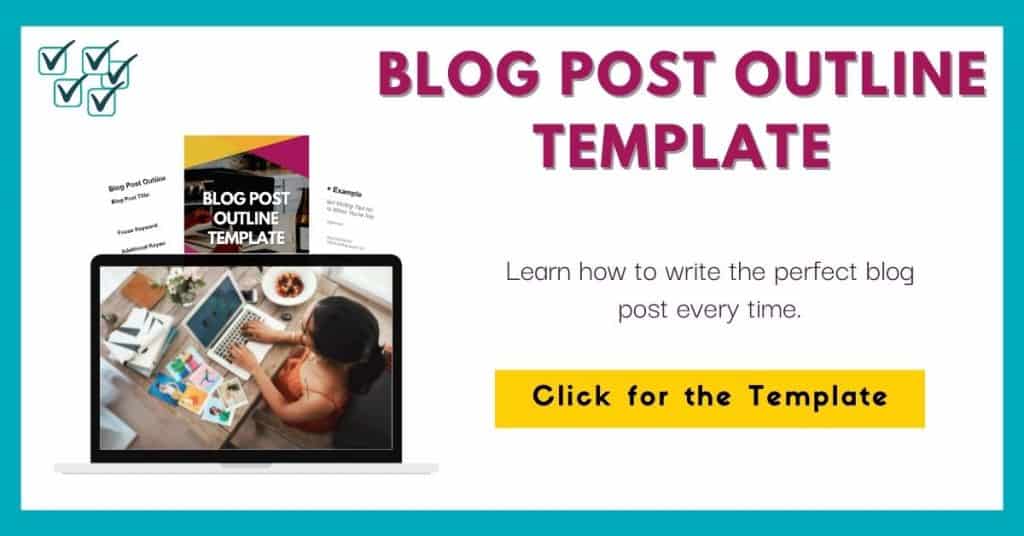
Step 5 – Create a Content Strategy and Plan
If you don’t have a content strategy and plan in place yet, now is the time to do it. Remember, your strategy is your vision, while your plan is the road map to get you there. Your content plan builds the bridge between your strategy and execution.
After you develop your strategy, you want to create your plan and editorial calendar. The strategy and plan include your new content as well as how you will repurpose old content.
Your plan will revolve around what you are selling because every piece of content you create should position you as an expert in a specific niche and prepare people to buy your services, products, and courses.
Once all that is laid out, you want to set a publishing schedule and deadlines so you can keep the momentum going and maintain consistency. This process includes choosing how often you publish a blog post and how frequently you want to post on your social channels.
And you may be wondering how many times you SHOULD be posting. There is no correct answer other than as many times you can commit to while maintaining consistency.
For most people, that is one blog post a week (and I wouldn’t go under that amount unless you’re established and have a lot of content). I post on social media five to seven days a week, but that may not be possible for you.
Only commit to what you can do realistically. That may be just three times a week, but whatever you decide, do it consistently.

Step 6 – Create New Content and Build a Repository
Now it’s time to create new content if you don’t have an established bank of content yet. That’s to be expected if you’re just starting, but at least you’ll have a strong content plan in place.
Creating new content may include written content like blog posts, white papers, case studies, etc. You will also want to create video content and social media posts for your audience.
If you have a good selection of content built up, you can start with your existing content and add that to your repurposing workflow. Remix and edit the pieces you already have and add new elements to enhance their value.
Take sections from an original blog post or reformat it into an audio file. Split up a blog series and make separate YouTube videos for each post. Think of ways to mix your content up.
Pro Tip – Use Zapier to help create a content repository of all your posts on social channels. This enables you to build up a library of content you can return to for repurposing time after time. You can also keep a running list of blog posts in something like Trello, ClickUp. or AirTable.
Step 7 – Optimize and Distribute
Whether starting fresh or trying to repurpose content, you need to optimize it for content distribution. This may mean optimizing it for search engines with relevant keywords and adding Instagram, Twitter, LinkedIn, or TikTok hashtags (and these are all different for these four platforms).
Creating visuals like social media graphics is also essential, and I batch design all my images too. It is a time-saver (and we are trying to save time wherever we can). Once your high-quality content is created, it’s time to share it on multiple platforms for maximum reach.
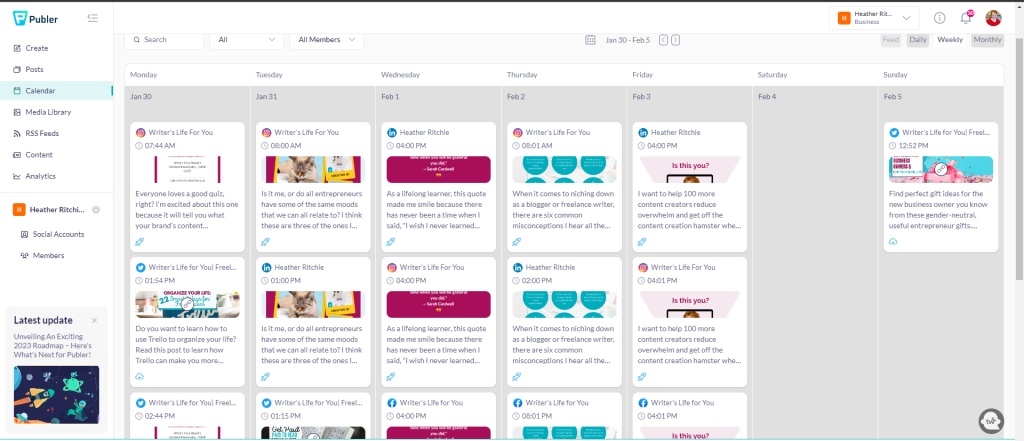
Step 8 – Schedule Your Content
Then make your life easier and invest in a good social media scheduler like Publer, SocialBee, CoSchedule, or something similar.
I like to batch all my content; I create my reels in batches of ten or 20, batch blog post outlines, and schedule my social media posts in batches. It will save you so much time. Schedule in advance, so it’s done, and you don’t have to worry about it.
Now your job doesn’t end there. Always analyze your content to see how it’s doing. You also want to respond to comments on your posts and think of calls to action that will increase audience engagement.
If something is not working, you may need to pivot. Maybe your audience doesn’t like watching short videos or listening to podcasts. Testing and analyzing are vital to making more money and growing your audience.
9. Analyze Your Content’s Performance and Adjust as Needed
Just like any other content you create, you want to analyze your newly repurposed content to see how it’s doing. Unfortunately, not every piece of content we make will do well. Analyzing it can tell you what is working and what’s not.
Trust me; this is not my favorite part of the process. And I didn’t do it when I started, but I soon realized that I was missing out on key data that could help me make better decisions when it came to content creation. How can you move forward if you don’t know what you’ve been doing is working?
There are paid, and free tools out there like:
- Keyword research tools
- Google Search Console
- Google Analytics
- Social media analytics
- Your scheduling tool’s analytics
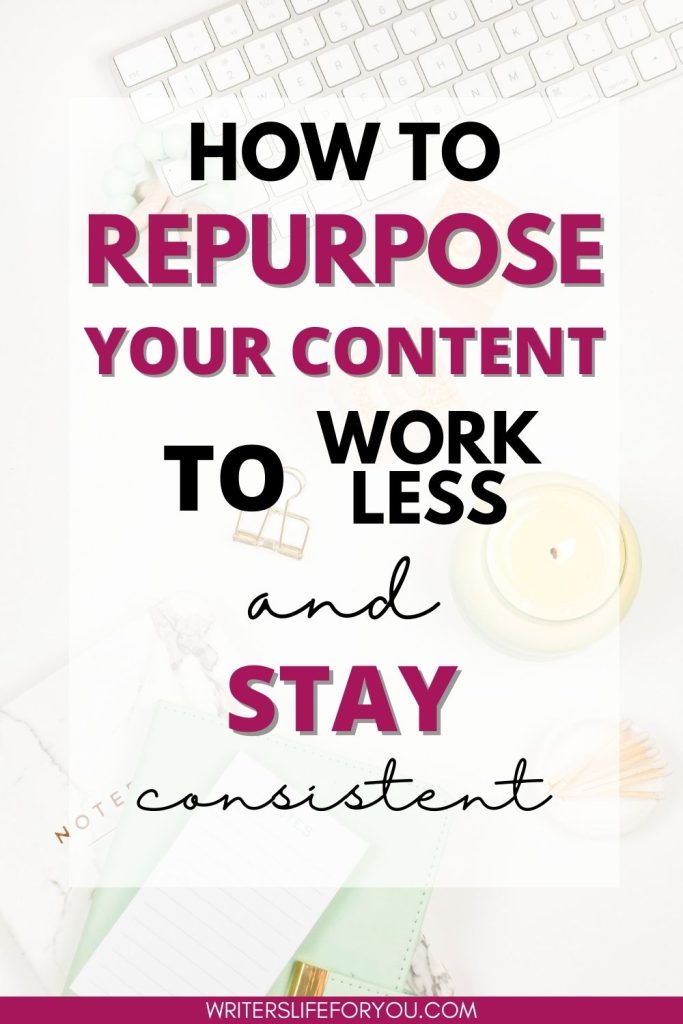
Real Example of Blog Content Repurposing
Watch this YouTube video as I show you how to get multiple pieces of content from one blog post.
Content Repurposing Tools
So, you may be wondering if there are some nifty tools to help you with content repurposing. These are some of my favorite tools that I use.
Repost – for getting watermarks off of Instagram reels or TikTok videos
The Viral Content Club by Viral Marketing Stars
Designrr for creating eBooks and flipbooks
Rev or Happy Scribe for transcribing videos
AirTable, ClickUp, or Trello for your content repository
Google Drive for file management and collaboration
Kapwing for GIFS, videos, and memes
Final Thoughts on Content Repurposing Workflow
Extend the mileage of your original content by repurposing and remixing it. Take social media posts and create new ones for different platforms and other channels.
Take old content and add to it to provide more value, or take an entire blog post and pull snippets to create a carousel post on Instagram. Or make short videos like Instagram reels or TikTok videos from an old post.
Honestly, the ways you can repurpose content are endless. Add this content repurposing workflow to your content plan and save time by reusing your old content.
You can even snag the list of tools I use to remix my old content and republish it on other social media platforms. I’m telling you, if you use this workflow, you can finally get more time back in your week. Won’t that be a relief?
To help you further, sign up for my list of ways to repurpose your content so you can get started today!
Related Posts to Content Repurposing Workflow
How to Use Trello to Organize Your Life: 22 Smart Ways
14 Best Tips on How to Plan Your Week to Be Productive Every Day
Gift Ideas for a New Business Owner: 13 Amazing Gifts for New Entrepreneurs
How to Create a Freelance Writer Bio That Wins Clients
How to Build Your First Freelance Writing Website in 7 Easy Steps
Freelance Writing vs. Blogging: Is One Better Than the Other
How to Make Money With WordPress in 48 Hours: 5 Clever Ways
The Best Content Repurposing Workflow for Solopreneurs and Online Business Owners

